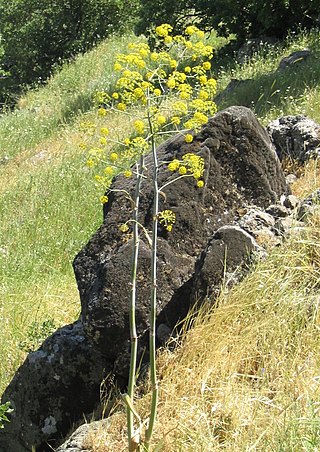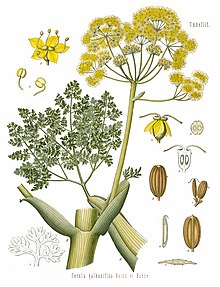
Apiaceae or Umbelliferae is a family of mostly aromatic flowering plants named after the type genus Apium and commonly known as the celery, carrot or parsley family, or simply as umbellifers. It is the 16th-largest family of flowering plants, with more than 3,800 species in about 446 genera, including such well-known and economically important plants as ajwain, angelica, anise, asafoetida, caraway, carrot, celery, chervil, coriander, cumin, dill, fennel, lovage, cow parsley, parsley, parsnip and sea holly, as well as silphium, a plant whose identity is unclear and which may be extinct.

In polymer chemistry and materials science, a resin is a solid or highly viscous substance of plant or synthetic origin that is typically convertible into polymers. Resins are usually mixtures of organic compounds. This article focuses on naturally occurring resins.

Asafoetida is the dried latex exuded from the rhizome or tap root of several species of Ferula, perennial herbs growing 1 to 1.5 m tall. They are part of the carrot family, Apiaceae. Asafoetida is thought to be in the same genus as silphium, a North African plant now believed to be extinct, and was used as a cheaper substitute for that historically important herb from classical antiquity. The species are native to the deserts of Iran and mountains of Afghanistan where substantial amounts are grown.

Silphium is an unidentified plant that was used in classical antiquity as a seasoning, perfume, aphrodisiac, and medicine. It also was used as a contraceptive by ancient Greeks and Romans. It was the essential item of trade from the ancient North African city of Cyrene, and was so critical to the Cyrenian economy that most of their coins bore a picture of the plant. The valuable product was the plant's resin.

Ferula is a genus of about 220 species of flowering plants in the family Apiaceae, native to the Mediterranean region east to central Asia, mostly growing in arid climates. They are herbaceous perennial plants growing to 1–4 m tall, with stout, hollow, somewhat succulent stems. The leaves are tripinnate or even more finely divided, with a stout basal sheath clasping the stem. The flowers are usually yellow, rarely white, produced in large umbels. Many plants of this genus, especially F. communis, are referred to as "giant fennel," although they are not fennel in the strict sense.

The House of the Spirits is a 1993 period drama film directed by Bille August and starring Jeremy Irons, Meryl Streep, Glenn Close, Winona Ryder, Antonio Banderas and Vanessa Redgrave. The supporting cast includes María Conchita Alonso, Armin Mueller-Stahl, and Jan Niklas. Based on the 1982 novel of the same name by Isabel Allende, the film follows three generations of women from a Chilean family during the country’s military dictatorship.
Ammoniacum or the gumammoniac is a gum-resin exuded from the several perennial herbs in the genus Ferula of the umbel family (Apiaceae). There are three types of ammoniacum: the gums ammoniac of Cyrenaica, of Persia, and of Morocco.
Sumbul, also called sumbal or muskroot, is a drug occasionally employed in European medical practice. It consists of the root of Ferula moschata, known formerly by the synonym Ferula sumbul, a tall umbelliferous plant of the 'giant fennel' genus Ferula found primarily in the north of Bokhara in present-day Uzbekistan, although its range apparently extends into Southeastern Siberia : beyond the Amur river.

Galbanum is an aromatic gum resin and a product of certain umbelliferous Persian plant species in the genus Ferula, chiefly Ferula gummosa and Ferula rubricaulis. Galbanum-yielding plants grow plentifully on the slopes of the mountain ranges of northern Iran. It occurs usually in hard or soft, irregular, more or less translucent and shining lumps, or occasionally in separate tears, of a light-brown, yellowish or greenish-yellow colour. Galbanum has a disagreeable, bitter taste, a peculiar, a somewhat musky odour, and an intense green scent. With a specific gravity of 1.212, it contains about 8% terpenes; about 65% of a resin which contains sulfur; about 20% gum; and a very small quantity of the colorless crystalline substance umbelliferone. It also contains α-pinene, β-pinene, limonene, cadinene, 3-carene, and ocimene.

Ferujol is a compound in the coumarin family, isolated from Ferula jaeschkeana.

Satyrus ferula, the great sooty satyr, is a butterfly of the family Nymphalidae.

Ferula tingitana, the giant Tangier fennel, is a species of the Apiaceae genus Ferula. Despite the name, the plant is not a type of fennel proper, which belongs to another genus (Foeniculum).

Ferula communis, the giant fennel, is a species of flowering plant in the carrot family Apiaceae. It is related to the common fennel, which belongs to the same family.

The papal ferula is the pastoral staff used in the Catholic Church by the pope. It is a rod with a knob on top surmounted by a cross. It differs from a crosier, the staff carried by other Latin Church bishops, which is curved or bent at the top in the style of a shepherd's crook.

Van herbed cheese is a type of cheese made out of sheep's or cow's milk. Ripened cheese varieties containing herbs are traditional in Turkey and have been manufactured for more than 200 years in the east and southeast of the country. They are manufactured from raw milk, semi-hard in texture and salty in taste and have the aroma of garlic or thyme due to added herbs. Twenty-five types of herb, including Allium, Thymus, Silene and Ferula species which are most popular, are used individually or as appropriate mixtures. The most popular of these cheeses is Otlu which is produced mainly in the Van Province of Turkey in small dairies and villages, but now is produced in other cities of the eastern region of Turkey and its popularity increases continuously throughout Turkey.
Derxia gummosa is a Gram-negative, rod-shaped, nitrogen-fixing, obligate aerobe bacterium of the genus Derxia. Colonies of D. gummosa produce a tenacious gum.

Pholiota gummosa, commonly known as the sticky scalycap, is a common species of mushroom-forming fungus in the family Strophariaceae. It is found in Europe and North America, where it grows as a saprotroph on the rotting wood of deciduous trees, including trunks and roots. It can also grow on wood buried near the surface, making it seem as if it is fruiting in grass.

Ferula narthex is a species of plant native to Afghanistan, Tajikistan, northern Pakistan and the Western Himalayan region of Pakistan. Although it is often listed as the source of asafoetida, one report stated that its essential oil lacked sulfur-containing compounds which are characteristic of asafoetida.

Ferula moschata, the musk root or sumbul, is a species of flowering plant in the family Apiaceae, found from Central Asia to western Xinjiang. Its roots are the source of muskroot, a substitute for animal musk in medicinal and perfumery applications.
















